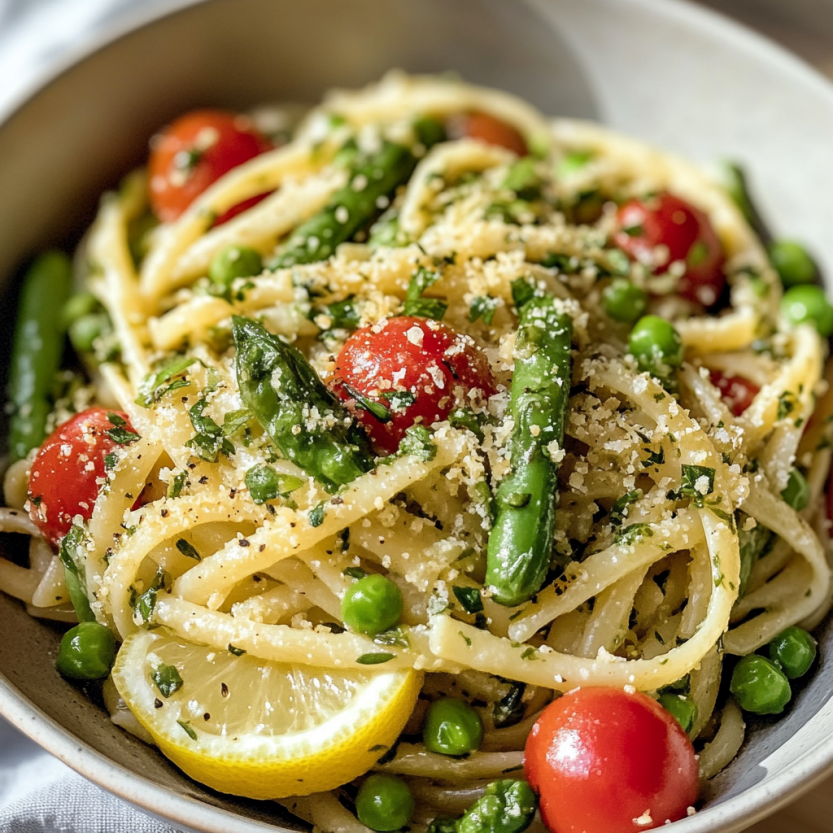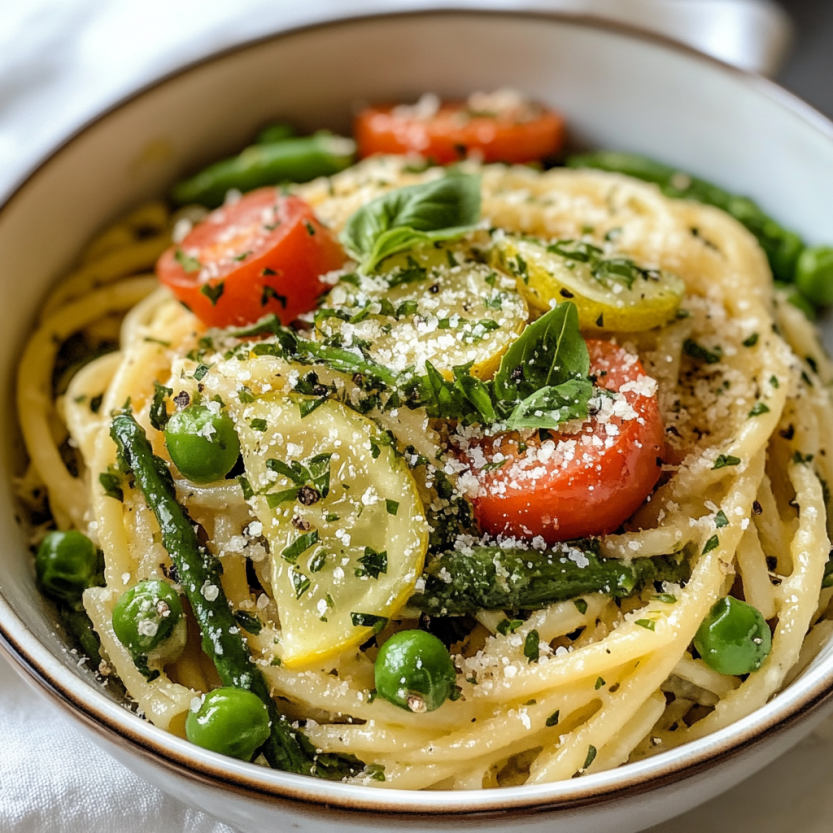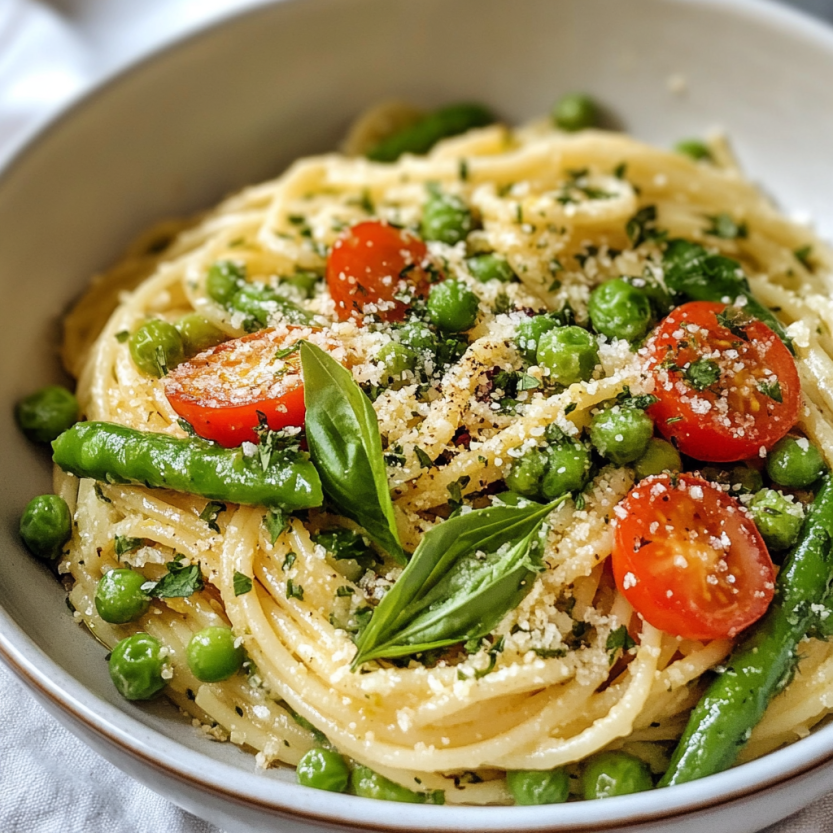 Save
Save
This lemon herb pasta with spring vegetables transforms simple ingredients into a vibrant, seasonal dish that celebrates the freshness of spring. The bright citrus notes complement the tender vegetables perfectly, creating a light yet satisfying meal that's ready in just minutes. I've been making this pasta for years whenever I spot the first asparagus of the season at my local farmer's market.
I first created this dish when my herb garden was overflowing with basil and I needed a quick way to showcase the season's bounty. Now it's become our family's official "spring has arrived" meal tradition that everyone looks forward to.
Ingredients
- 12 oz pasta: spaghetti or penne work beautifully as they capture the light sauce perfectly
- 1 cup asparagus: the quintessential spring vegetable that adds a tender crisp texture look for bright green stalks with tightly closed tips
- 1 cup cherry tomatoes: adds bursts of juicy sweetness choose vine-ripened ones for best flavor
- 1 cup peas: fresh or frozen both work wonderfully for that sweet pop in every bite
- 1/4 cup olive oil: use a good quality extra virgin for the best flavor profile
- Juice and zest of 1 lemon: provides the bright backbone of the dish Meyer lemons work especially well if you can find them
- 2 cloves garlic: minced finely for aromatic flavor without overpowering the delicate herbs
- 1/4 cup fresh basil: the aromatic heart of this dish always opt for fresh rather than dried
- 1/4 cup grated Parmesan cheese: adds savory depth and creaminess choose freshly grated for optimal meltability
- Salt and pepper to taste: essential for balancing and enhancing all the flavors
Step-by-Step Instructions
- Cook the Pasta and Vegetables:
- Bring a large pot of generously salted water to a rolling boil. Add your pasta and cook according to package directions until al dente. During the final 3 minutes of cooking time add the asparagus and peas to the same pot. This gently cooks the vegetables while saving you time and an extra pot. Reserve about 1/4 cup of pasta water before draining everything together in a colander.
- Prepare the Lemon Garlic Sauce:
- While the pasta cooks take a large serving bowl and whisk together the olive oil lemon juice lemon zest and minced garlic until well combined. Season with salt and freshly ground black pepper. The warm pasta will slightly cook the garlic when added removing any harsh raw flavor while preserving its aromatic qualities.
- Combine Everything:
- Add the hot drained pasta asparagus and peas directly to the bowl with the lemon sauce. Toss thoroughly to coat every strand with the bright sauce. The residual heat will help the flavors meld together beautifully. Gently fold in the halved cherry tomatoes being careful not to crush them.
- Finish and Serve:
- Sprinkle the fresh chopped basil and Parmesan cheese over the pasta and toss once more to incorporate. Taste and adjust seasoning with additional salt pepper or lemon juice if needed. Serve immediately while warm or let cool to room temperature for a delightful spring pasta salad.
 Save
Save
The lemon zest is truly the secret ingredient in this recipe. I discovered its importance completely by accident when I was low on lemon juice and added extra zest to compensate. The oils in the zest provide an incredible aromatic quality that permeates the entire dish with citrus notes in a way that juice alone never could.
Make Ahead Options
This pasta dish shines as a make-ahead option for busy weeks. You can prepare it fully up to 2 days in advance and store it in an airtight container in the refrigerator. The flavors actually develop and meld together beautifully over time making it even more delicious on day two. When ready to serve simply bring to room temperature or gently warm it in a skillet with a splash of water or olive oil to refresh the sauce. This has saved me countless times when hosting spring gatherings where I want to focus on my guests rather than last-minute cooking.
Seasonal Adaptations
One of the reasons I return to this recipe throughout the year is its incredible adaptability to whatever vegetables are currently in season. In early spring use tender young asparagus peas and spring onions. During summer swap in zucchini bell peppers and cherry tomatoes from the garden. For fall try butternut squash cubes and kale briefly blanched with the pasta. Winter calls for heartier additions like roasted Brussels sprouts and sun-dried tomatoes. The lemon herb base complements virtually any seasonal vegetable allowing this recipe to evolve with your farmers market finds throughout the year.
 Save
Save
Serving Suggestions
This versatile pasta works beautifully as both a main dish or a sophisticated side. For a complete meal serve it alongside a simple protein like grilled chicken lemon garlic shrimp or white beans sautéed with herbs for a vegetarian option. It also makes an excellent contribution to a spring brunch alongside a frittata and fresh fruit. For entertaining I often serve it slightly cooled as part of a buffet spread where it holds up beautifully without becoming soggy. A chilled glass of Sauvignon Blanc or Pinot Grigio makes the perfect beverage pairing bringing out the citrus notes in the dish.
Recipe Questions
- → Can I use different vegetables in this pasta dish?
Absolutely! While asparagus, peas, and cherry tomatoes work beautifully with the lemon-herb flavors, you can substitute with other spring vegetables like tender young zucchini, artichoke hearts, or snap peas. Just adjust cooking times accordingly as some vegetables may require more or less time than others.
- → Is this dish suitable for meal prep?
Yes! You can prepare this dish ahead of time and store in the refrigerator for 2-3 days. The flavors actually develop nicely as it sits. For best results, you might want to add the fresh basil just before serving, and perhaps a splash of lemon juice to brighten it up.
- → What herbs work best with this lemon pasta?
While basil is specified in the ingredients, other herbs that pair wonderfully with the lemon include mint, chives, parsley, dill, or a combination. Fresh herbs are preferred for their bright flavor, but dried herbs can work in a pinch—just use about one-third the amount.
- → What's the best pasta shape to use?
Spaghetti and penne are recommended, but this versatile dish works well with many pasta shapes. Long pastas like linguine or fettuccine catch the sauce nicely, while shapes with ridges or hollows like rotini, farfalle, or orecchiette can trap bits of vegetables and herbs for more flavor in each bite.
- → How can I make this dish creamier?
For a creamier version, reserve 1/4 cup of pasta cooking water before draining and add it to your sauce along with an extra tablespoon or two of olive oil. You could also add a splash of heavy cream or cream cheese, or for a vegan option, blend 1/4 cup of the cooked peas with a little olive oil and lemon juice to create a smooth, green sauce.
- → Can I serve this pasta cold as a salad?
Definitely! This dish makes an excellent pasta salad. After cooking, rinse the pasta and vegetables under cold water to stop the cooking process, then toss with the dressing ingredients. Chill for at least an hour before serving for the flavors to meld.